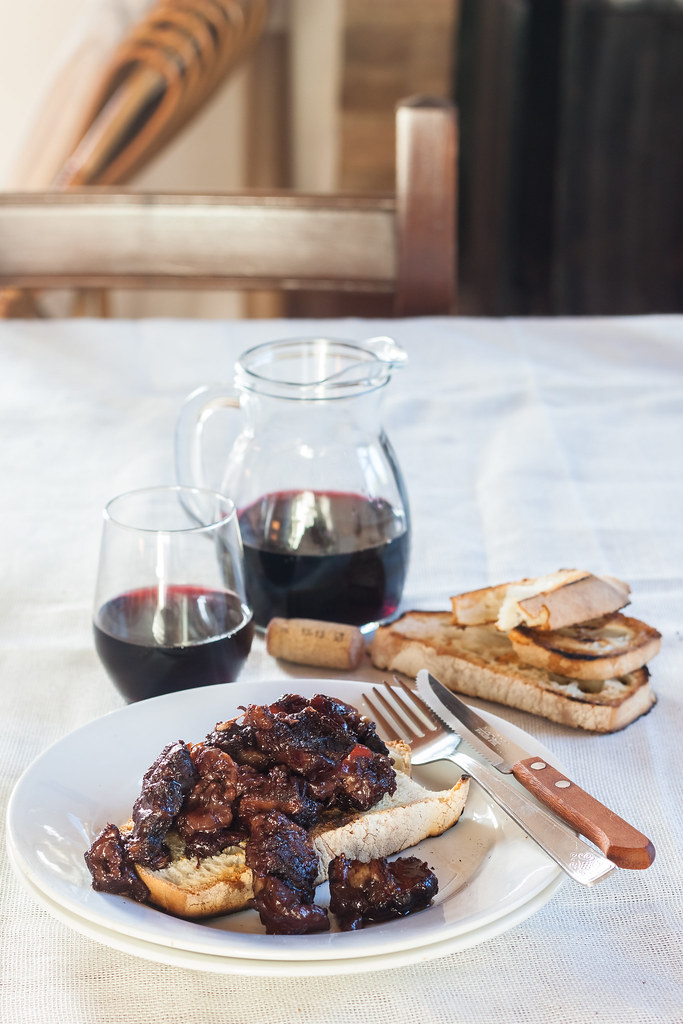Peposo, a black peppercorn beef stew, Brunelleschi’s favourite dish
Ten days ago I walked up there, along a thin line between sky and earth, on the narrow corridors that run all around the roof of Santa Maria del Fiore Cathedral, in close contact with bricks, tiles, statues and engravings which date back to the Renaissance time, masterpieces which made Florence famous all over the world. Brunelleschi’s dome was so close, you almost could touch it if you stretched your arm, yet it was, if possible, even more imposing and majestic.

Despite the gray sky the unusual sight on the roofs of Florence was worth the thousands of steps we had to climb to get up there. Ok, no, you’re right, they were not thousands, probably they were just hundreds of steps, but I assure you that they seemed endless. Then you climb even higher, over the walkways along poorly lit spiral staircases that bring you back to Brunelleschi’s time. Imagination, or lack of oxygen due to the steep stairs, play tricks on you and they no not look like light bulbs, but torches and everything is covered by a mysterious charm…

In such a charming, rarefied, poetic and artistic place, above the roofs of one of the city I love the most in the world, in the midst of so many photographers and travel bloggers, I, a food blogger, what could I do but end up talking about food? Fresh air always whet the appetite, you know, and then, there I was perfectly entitled to talk about a particular dish, which is strictly connected to the building of the dome of the cathedral…
Apparently Filippo Brunelleschi, the most famous architect of the Italian Renaissance, used to visit frequently Impruneta, a small hill town near Florence, to check the production of the terracotta tiles that would later make world famous the dome of the Duomo of Florence.

The Impruneta craftsmen have always been famous for the jars, tiles and vases made with their renowned earthenware. Along with the Tuscan terracotta, they became famous also for the as much glorious peposo, a black peppercorn beef stew: the meat was simmered with patience, for a very long time, at the mouth of the old ovens. The ingredients were few and simple, just marbled meat, which takes some time to be cooked but eventually turns out soft and juicy, black peppercorns and red wine. No tomato sauce though, since the import of tomatoes from America was still far to come.
It is said to have been Brunelleschi’s favourite. If it inspired the Florence dome, it is definitely worth the 3 hour simmering on low heat.

If Julia Child used to say I enjoy cooking with wine, sometimes I even put it in the food, I could change it into: I usually don’t drink wine, but I love to cook with it. I always have leftover wine from my cooking classes in my pantry, so I use it to make peposo or even one of my favourite pasta sauces, sugo finto.
Il peposo dell'Impruneta
Print Recipe Pin Recipe Share by EmailIngredients
- about 600 g Maremmana beef shank
- 1 tablespoon crushed black peppercorns, collected in a small cheesecloth
- 500 ml of Chianti red wine
- Salt
Instructions
- Cut the meat into pieces about two centimetres large and let it brown in a pan without adding anything, neither olive oil or butter.
- Once the meat chunks are browned on all sides, add the sachet with the crushed peppercorns and pour in all the red wine.
- Cook covered for at least one hour and a half, checking occasionally that the wine does not dry out completely.
- After the two hours, pour in about 350 ml of water and add a good pinch of salt, then simmer for another hour, reducing almost all the cooking liquid. If necessary add more salt.
- Serve hot with crusty bread.

Which is your favourite recipe to use leftover red wine? Drink it doesn’t count!










Oh, I’d love to go up there and take pictures of Florence! Your photos are truly beautiful and that rustic dish is mouthwatering.
Cheers,
Rosa
Brunelleschi was a perfectionist — his frequent visits to Impruneta were to make sure each and every tile was perfect. Probably while he was there, he’d need a bite to eat, right? I’ve even heard that the pots of peposo were cooked together in the kilns where the terracotta tiles were actually baking! Well, why not?
but yes, of course!
What an absolute delight, I bet the taste is deep. How beautiful are those pictures of florence, I’m looking forward to visiting and seeing it all myself. Lovely post as always dear x
Thanks for this great recipe!
Here’s our take on it:
http://www.saltylips.com.ar/2014/03/peposo.html
Greetings from Argentina.